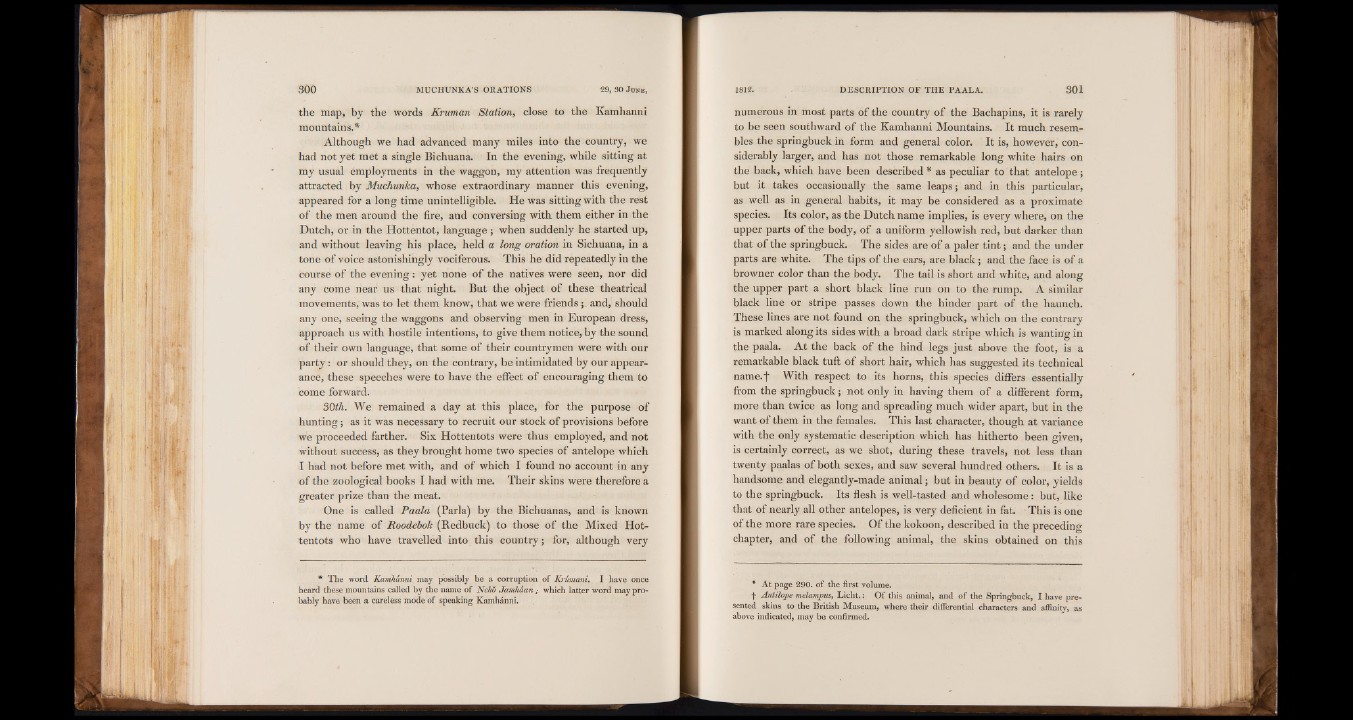
the map* by the words Kruman Station, close to the Kamhanni
mountains.*
Although we had advanced many miles into the country, We
had not yet met a single Bichuana. In the evening, while sitting at
my usual employments in the waggon, my attention was frequently
attracted by Muchunka, whose extraordinary manner this evening,
appeared for a long time unintelligible. He was sitting with the rest
of the men around the fire, and conversing with them either in the
Dutch, or in the Hottentot, language; when suddenly he started up,
and without leaving his place, held a long oration in Sichuana, in a
tone of voice astonishingly vociferous. This he did repeatedly in the
course of the evening: yet none of the natives were seen, nor did
any come near us that night. But the object of these theatrical
movements, was to let them know, that we were friendsand, should
any one, seeing the waggons and observing men in European dress,
approach us with hostile intentions, to give them notice, by the sound
of their own language, that some of their countrymen were with our
party: or should they, on the contrary, be intimidated by our appearance,
these speeches were to have the effect of encouraging them to
come forward.
30th. We remained a day at this place, for the purpose of
hunting; as it was necessary to recruit our stock of provisions before
we proceeded farther. Six Hottentots were thus employed, and not
without success, as they brought home two species of antelope which
I had not before met with, and of which I found no account in any
of the zoological books I had with me. Their skins were therefore a
greater prize than the meat-
One is called Paala (Parla) by the Bichuanas, and is known
by the name of Roodebok (Redbuck) to those of the Mixed Hottentots
who have travelled into this country; for, although very
* The word Kamhanni may possibly be a corruption of Krimani. I have once
heard these mountains called by the name of Ncho J a m h a a n which latter word may probably
have been a careless mode of speaking Kamhanni.
numerous in most parts of the country of the Bachapins, it is rarely
to be seen southward of the Kamhanni Mountains. It much resembles
the springbuck in form and general color. It is, however, considerably
larger, and has not those remarkable long white hairs on
the back, which have been described * as peculiar to that antelope;
but it takes occasionally the same leaps; and in this particular,
as well as in general habits, it may be considered as a proximate
species. Its color, as the Dutch name implies, is every where, on the
upper parts of the body, of a uniform yellowish red, but darker than
that of the springbuck. The sides are of a paler tint; and the under
parts are white. The tips of the ears, are black; and the face is of a
browner color than the body. The tail is short and white, and along
the upper part a short black line run on to the rump. A similar
black line or stripe passes down the hinder part of the haunch.
These lines are not found on the springbuck, which on the contrary
is marked along its sides with a broad dark stripe which is wanting in
the paala. At the back of the hind legs just above the foot, is a
remarkable black tuft of short hair, which has suggested its technical
name.f With respect to its horns, this species differs essentially
from the springbuck; not only in having them of a different form,
more than twice as long and spreading much wider apart, but in the
want of them in the females. This last character, though at variance
with the only systematic description which has hitherto been given,
is certainly correct, as we shot, during these travels, not less than
twenty paalas of both sexes, and saw several hundred others. It is a
handsome and elegantly-made animal; but in beauty of color, yields
to the springbuck. Its flesh is well-tasted and wholesome: but, like
that of nearly all other antelopes, is very deficient in fat. This is one
of the more rare species. Of the kokoon, described in the preceding
chapter, and of the following animal, the skins obtained on this
* At page 290. of the first volume,
f Antilope melampus, Licht.: Of this animal, and of the Springbuck, I have presented
skins to the British Museum, where their differential characters and affinity, as
above indicated, may be confirmed.